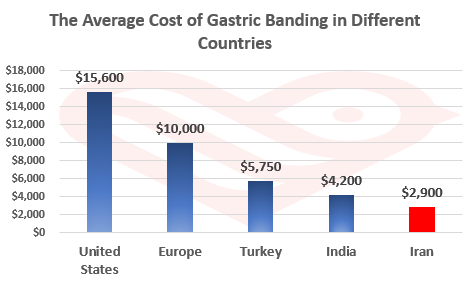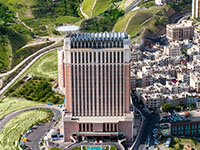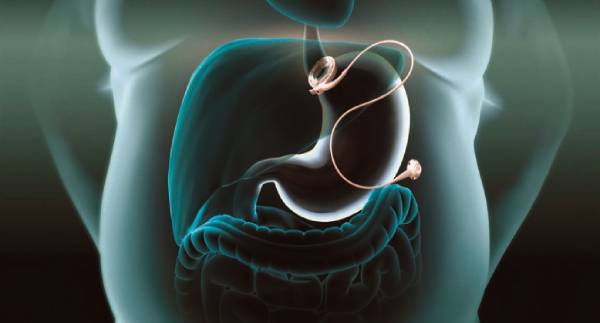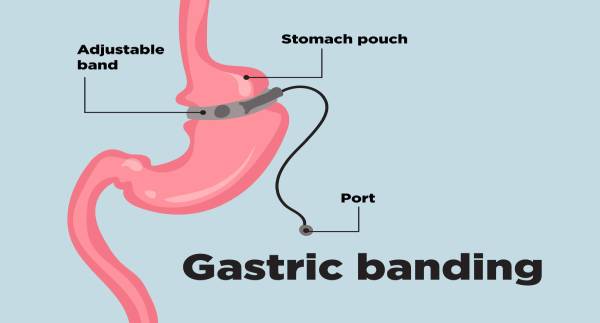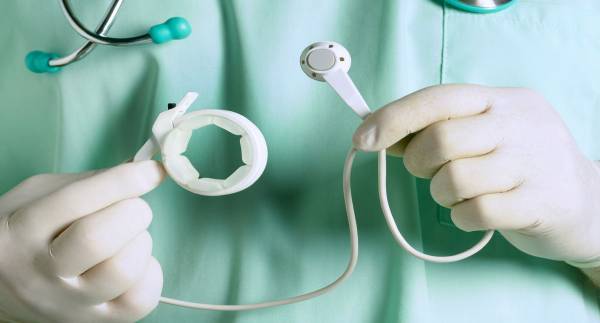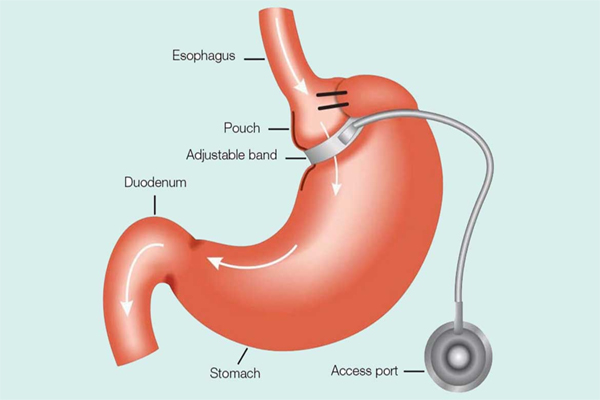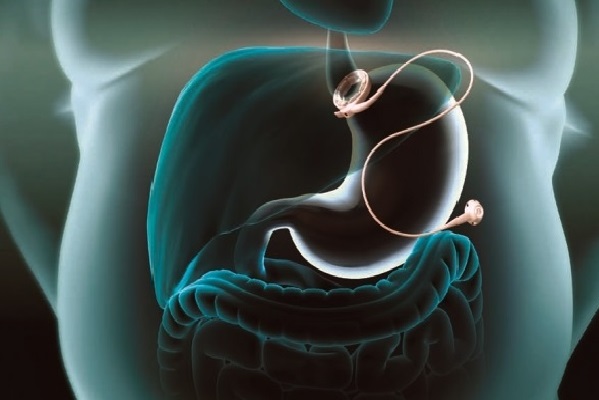Gastric banding is a surgical obesity treatment. This method, which is one of the different types of obesity treatment, causes the stomach to contract and makes the person feel full faster by eating less food. According to research, gastric banding is one of the most common methods for treating obesity that is performed in many countries such as Iran.
The condition that makes gastric banding one of the most popular ways to treat obesity is that this type of surgery is a reversible surgery, which means that you can restore your physical condition in case of any problems. In addition, gastric banding poses minimum harm on you compared to other procedures and can be considered a safe surgery.
An inflatable band is mounted on top of your stomach in gastric banding, resulting in a decrease in your appetite, causing the person to eat less food. After surgery, you are allowed to drink only clear liquids for 6 weeks and gradually switch to regular foods. Gastric banding helps with weight loss and obesity-related complications such as diabetes.
How is gastric banding surgery performed?
In this method of treating obesity, a silicone strip is placed near the upper part of the stomach. This strip reduces the stomach volume and ultimately reduces appetite. It is an FDA-approved method as a successful treatment for dangerous obesity. In addition to inserting a silicone band, the surgeon attaches a tube that you can detect under the skin of the abdomen. A saline solution is injected into the stomach to inflate the band using this tube.
This way, the stomach volume will be lower and the stomach can no longer tolerate large amounts of food, so the person will consume less food. In general, by doing so, the appetite decreases. People will feel full sooner and consume less food. As a result, they will experience decent weight loss.
Who is a Good Candidate for Gastric Banding?
In the past, gastric banding was recommended only if a person’s body mass index (BMI) was 35 or higher. Some people with a BMI of 30 to 34.9 used this method to lose weight if there were other obesity-related problems, including diabetes, hypertension, or sleep apnea. This strictness for gastric banding was due to its high risk in the past. But today, advances in surgical techniques have improved the safety record of this procedure. If a person’s body mass index is between 30 and 35 and fails to lose weight through non-surgical methods such as diet, physical activity, or taking various medications, the doctor will explain to them whether gastric banding is appropriate for them depending on their physical condition. Gastric banding may not be right for you if you are addicted to drugs or alcohol, have an uncontrolled psychiatric illness, or can lose weight easily through diet and exercise.
Gastric Banding Preoperative Instructions
Before the surgery, you should follow some steps to prepare for gastric banding surgery, including:
1- Start an exercise program and continue it to reach your weight loss goals and keep your weight stable.
2- Reduce your daily calories in a range between 1200 and 1,500 calories (or within the range, your doctor has told you).
3- Avoid caffeinated beverages for about a month before surgery.
Life After Gastric Banding Surgery
Gastric banding is an easier operation than gastric bypass. It is the least risky compared to other methods. The surgeon makes between one and five small incisions in the abdomen. This procedure often takes 30 to 60 minutes. The patient should not eat from the night before surgery.
Most people can resume most of their normal activities after 2 days. But they may need to take a week off work. Immediately after gastric banding surgery, you will feel some pain and discomfort that can be controlled by medications. This is part of the normal recovery phase after any surgery.
Generally, after 6 to 8 weeks, normal activities can be resumed. Weight loss with gastric banding is a gradual process. At first, weight loss may be more dramatic. For example, you may lose 2 to 3 kg per week. However, in the long run, this weight loss generally decreases to one kilogram per week. Naturally, your choice of food will affect the amount of weight loss.
After about 18 months, weight loss slows down significantly. The average weight loss for this procedure is 40% of excess body weight in the first year and an extra 10% to 20% in the second year. Patients are usually asked to keep in touch with their surgeon regularly during this period because they may need further care.
Possible Risks of Gastric Banding Surgery
Side effects of gastric banding include nausea and vomiting, ulcers at the site of the bandage, esophageal reflux, indigestion, weight recovery, and dehydration.
Because this type of surgery is a restrictive procedure and does not cause nutrient malabsorption, vitamin deficiency is not usually seen. However, many centers recommend multivitamin supplements. You may experience constipation after surgery.
Gastric banding carries fewer risks than other weight loss methods. This method has recorded fewer deaths than other methods. There is a possibility that the band will slip in the stomach, and it may even wear out in the stomach. Other complications may include infection, bleeding, or pain in the abdominal area.
Benefits of Gastric Banding
Below we will list some of the benefits of gastric banding:
1- The safest way to lose weight
Compared to other methods of treating obesity, which include incisions in the stomach, gastric banding surgery carries the lowest risk. Instead of an incision, the surgeon places the rubber strip on the upper part of the stomach using a laparoscope. When the band is placed in the stomach, it is inflated with air, which divides the stomach into two parts. The top is smaller and the bottom is larger. If you feel uncomfortable or undesired side effects uccur , the band will be removed the same way it was mounted. The best benefit of this method is that no wound will remain on the body for healing.
2- It is reversible
Other bariatric surgeries such as gastric bypass include incisions in the larger part of the stomach. You will have wounds and permanent somewhat unsightly scars on your abdomen. The good news about gastric banding surgery is that you can remove the band if you feel some kind of discomfort or severe negative effects. Removal is done using a laparoscope and takes only a few minutes.
3- Dumping Syndrome does not occur after Gastric Banding
Dumping syndrome is a condition in which the new size of the stomach cannot return to the same size as before the meal. Any amount of food that the patient eats can cause nausea and even vomiting. This is a common side effect among patients of bariatric surgery such as gastric bypass. This is due to a wound that occurs after the incision when the larger part of the stomach is removed. With gastric banding surgery, there is no dumping syndrome because no incisions are made.
3- Shorter Hospitalization
Gastric banding surgery takes less time than other forms of bariatric surgery. The surgeon only inserts the bandage and that’s it. This procedure will be done in the shortest possible time and then you will return home. This method is quite convenient because you do not need to be hospitalized.
4- It is effective for weight loss
Although the rate of weight loss by this method may not be consistent with other obesity surgeries, it is still an effective way to lose excess weight. As a result, the weight loss rate of this method is more than you can lose weight through other weight loss methods such as exercise and diet.
Disadvantages of Gastric Banding
Here are some disadvantages of gastric banding:
1 - Less weight loss
The main disadvantage of gastric banding surgery is that it causes less weight loss compared to other surgeries. This difference is due to removing the larger part of the stomach in other obesity surgeries, causing more feeling of fullness. With gastric banding surgery, the hormone that causes hunger is still present and therefore results in less weight loss.
2- There is a possibility of regaining weight
Because no part of the stomach is removed in this surgery, the hormones that control satiety are not affected in any way. If this method is not accompanied by physical exercise and a healthy lifestyle, the patient can get used to the new size of the stomach. When this happens, the patient can eat the same amount of food he did before surgery, leading to a regain of weight.
It is important to note that most of the side effects of bariatric surgeries are due to the patient’s negligence.
Gastric Banding Diet
A gastric banding diet helps people who are recovering from gastric banding to change their eating habits. A gastric banding regimen is designed to facilitate the recovery period of the stomach.
Gastric Banding Diet Details
Dietary recommendations after gastric banding surgery vary depending on your circumstances. A gastric banding diet usually follows a consistent process to help you digest solid foods more easily. You can usually start eating regular foods about three months after surgery.
Tips you should follow in this diet include:
1- Drink 2 liters of fluids a day to prevent dehydration.
2- Drink liquids between meals, not during meals. Wait about 30 minutes after meals, then drink liquids and avoid drinking liquids 30 minutes before meals.
3- Eat and drink slowly to prevent dumping syndrome.
4- Eat low-fat and high-protein foods daily.
5- Choose foods and beverages that are low in fat and sugar.
6- Avoid alcohol.
7- Limit caffeine consumption, which can cause dehydration.
8- Take vitamin and mineral supplements every day as directed by your doctor.
Suitable Drinks After Gastric Banding
For the first day or so after surgery, you can only drink clear fluids. You can use the following liquids:
1- Water
2- Caffeine-free tea or coffee
3- Milk (skim or 1% fat)
4- Gelatin or sugar-free minerals
After about a week of fluid foods, you can start eating refined and mashed foods. You can eat three to six small meals a day. Each meal should consist of 4 to 6 tablespoons. Eat slowly and allow about 30 minutes for each meal.
Suitable Pureed Foods after Gastric Banding
Choose foods that are well-pureed, such as:
1- Minced meat, chicken, or lean fish
2- Cheese
3- Soft eggs
4- Cooked cereals
5- Soft fruits and cooked vegetables
6- Cream soup
After a few weeks of eating mashed food and with your doctor’s approval, you can add soft foods to your diet. Your food should be in small, soft pieces, and easy to chew. You can eat three to five small meals a day. Each meal should consist of one-third to one-half of a cup.
Suitable Soft Foods after Gastric Banding
1- Lean ground meat or chicken
2- Eggs
3- Cheese
4- Cooked or dried grains
5- Rice
6- Freshly canned or soft fruit, without seeds and skin
7- Cooked vegetables
Suitable Solid Foods after Gastric Banding
After about eight weeks on a gastric banding diet, you can gradually return to eating slightly solid foods and start by eating three slightly solid meals a day. It is important to stop eating before you feel full. Depending on your solid food tolerance, you may be able to change the number of meals and the amount of food in each meal. Try new foods one by one. Some foods may cause pain, nausea, or vomiting after gastric banding surgery.
Foods to Avoid after Gastric Banding
Foods that can cause problems at this stage include:
- Bread
- Carbonated drinks
- Raw vegetables
- Red meat
- Fried foods
- Nuts
- Popcorn
Gastric Banding in Iran
Since highly skilled surgeons are present in Iran to perform various operations, lap-ban gastric banding also has its specialists. People from all over Iran and the world can benefit from highly experienced specialists and medical facilities at the lowest cost and highest quality. There are equipped clinics for gastric banding surgery in different cities of Iran, including Tehran, Isfahan, Shiraz, Mashhad, Tabriz, and Kish Island.
